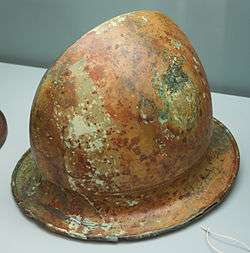Negau helmet
The Negau helmets are 26 bronze helmets (23 of which are preserved) dating to c. 450 BC–350 BC, found in 1812 in a cache in Ženjak, near Negau, Duchy of Styria (now Negova, Slovenia).[1] The helmets are of typical Etruscan 'vetulonic' shape, sometimes described as of the Negau type. They were buried in c. 50 BC, shortly before the Roman invasion of the area. Helmets of the Negau type were typically worn by priests at the time of deposition of these helmets, so they seem to have been left at the Ženjak site for ceremonial reasons. The village of Ženjak was of great interest to German archaeologists during the Nazi period and was briefly renamed Harigast during World War II. The site has never been excavated properly.

Inscriptions
On one of the helmets ("Negau B"), there is an inscription in a northern Etruscan alphabet. The inscription need not date to c. 400 BC, but was possibly added by a later owner in c. 2nd century BC or later. It is read as:
- 𐌇𐌀𐌓𐌉𐌊𐌀𐌔𐌕𐌉𐌕𐌄𐌉𐌅𐌀///𐌉𐌐
- harikastiteiva\\\ip,
Many interpretations of the inscription have been proffered in the past, but the most recent interpretation is by T.L. Markey (2001), who reads the inscription as 'Harigast the priest' (from *teiwaz "god"), as another inscribed helmet also found at the site bears several names (mostly Celtic) followed by religious titles.
In any case, the Germanic name Harigast is almost universally read. Formerly, some scholars have seen the inscription as an early incarnation of the runic alphabet, but it is now accepted that the script is North Etruscan proper, and precedes the formation of the Runic alphabet. Harigast constitutes an attestation of the Germanic sound shift, probably the earliest preserved, preceding Tacitus perhaps by some two centuries.[1]
Must (1957) reads Hariχas Titieva as a Raetic personal name, the first element from the Indo-European (Venetic rather than Germanic), the second from the Etruscan.
The four discrete inscriptions on the helmet usually called "Negau A" are read by Markey as: Dubni banuabi 'of Dubnos the pig-slayer'; sirago turbi 'astral priest of the troop'; Iars'e esvii 'Iarsus the divine'; and Kerup, probably an abbreviation for a Celtic name like Cerubogios.
See also
References
- Jeremy J. Smith (2 April 2009). Old English: A Linguistic Introduction. Cambridge University Press. pp. 125–. ISBN 978-0-521-86677-4.
- Markey, Tom (2001). "A Tale of Two Helmets: The Negau A and B Inscriptions". Journal of Indo-European Studies. 29 (1/2): 69–172.
- Must, Gustav (1957). "The Problem of the Inscription on Helmet B of Negau". Harvard Studies in Classical Philology. 62: 51–59. JSTOR 310966.
External links
| Wikimedia Commons has media related to Negau helmets. |
- "The Negau helmet". TITUS (project). 2001.
